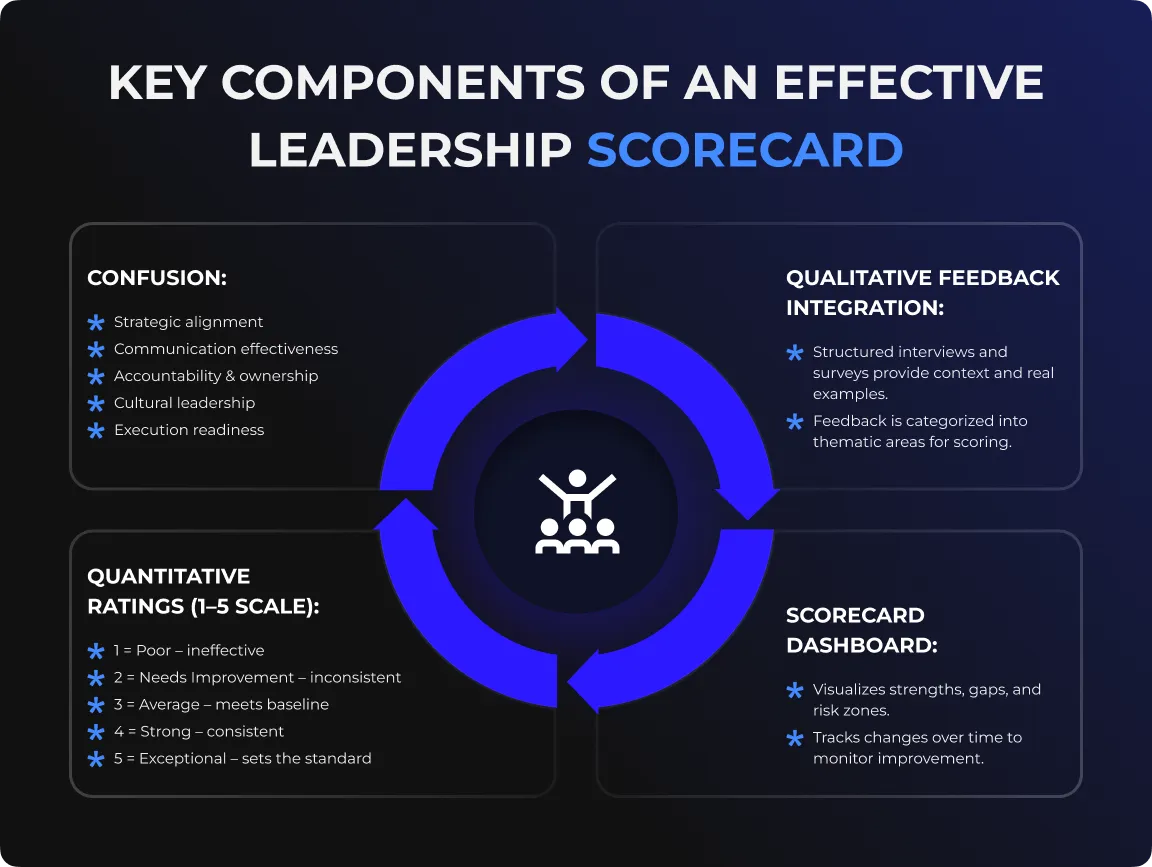Leadership Scorecards: Turn Feedback Into Performance

From Feedback to Focus: Using Leadership Scorecards to Drive Performance
The Problem with Vague Leadership Feedback
Leadership assessments often fall into the trap of anecdotal feedback:
- “We need better communication.”
- “Leaders should be more accountable.”
- “There’s a lack of alignment.”
These statements are directionally helpful, but they are too subjective to drive meaningful change. Without a structured way to measure leadership effectiveness, teams struggle to translate feedback into focused action. That is where Leadership Scorecards come in.
What Is a Leadership Scorecard?
A Leadership Scorecard is a structured tool that:
- Translates qualitative feedback into quantitative ratings
- Measures leadership effectiveness across key competencies
- Tracks progress over time with clear, objective data
It provides a clear picture of how well leadership teams are aligned, accountable, and executing on strategic priorities.
Why Leadership Scorecards Matter
Leadership Scorecards:
- Create accountability by setting clear expectations
- Align leadership behaviors with company values and goals
- Provide measurable benchmarks for improvement
- Enable data-driven coaching and development
Instead of relying on subjective perceptions, scorecards give leaders and organizations a factual basis to track performance and drive focused development.
Key Components of an Effective Leadership Scorecard
Competency Areas to Measure
- Strategic alignment
- Communication effectiveness
- Accountability and ownership
- Cultural leadership
- Execution readiness
Qualitative Feedback Integration
- Structured interviews and surveys provide context and real examples
- Feedback is categorized into thematic areas for scoring
Quantitative Ratings (1–5 Scale)
- Poor (1): Capability is ineffective or absent
- Needs Improvement (2): Inconsistent performance, unclear expectations
- Average (3): Baseline performance, meets minimum expectations
- Strong (4): Reliable and consistent performance
- Exceptional (5): Exemplifies excellence, sets the standard
Scorecard Dashboard
- Visualizes strengths, gaps, and risk zones
- Tracks changes over time to monitor improvement

Turning Insight into Action
The scorecard is not the end goal. It is the starting point for targeted action:
- Identify leadership gaps that hinder execution
- Prioritize coaching and development initiatives
- Align leadership behaviors with strategic imperatives
- Monitor progress and recalibrate as needed
Real-World Example: Scorecards in Action
A mid-market company used a Leadership Scorecard to assess post-acquisition integration readiness. Findings revealed gaps in accountability and cross-functional communication. By targeting these areas with focused coaching and new leadership routines, the company achieved:
- 18% improvement in execution speed
- Increased leadership engagement
- Enhanced alignment across departments
The structured approach provided clarity and focus, accelerating leadership effectiveness.
The Payoff: Data-Driven Leadership Excellence
Leadership Scorecards transform ambiguous feedback into actionable insights. They enable organizations to develop high-performing leadership teams that are aligned, accountable, and execution-ready.
Final Thoughts
If you want to drive real change, you need more than gut-feel feedback. Leadership Scorecards provide a fact-based, structured approach to measure, align, and improve leadership effectiveness, ensuring your team is equipped to execute and grow.
Ready to turn leadership feedback into focused action? Let’s build a Leadership Scorecard tailored to your organization’s goals.
